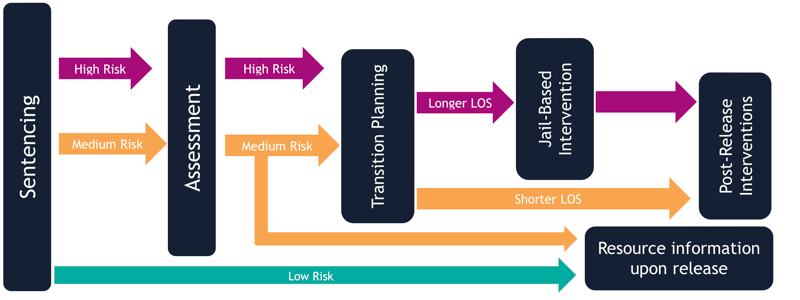Transition from Jail
Assessment plays a fundamental role in reducing risk to reoffend for people returning to the community from jail. Here are four questions you should ask yourself as you plan or seek to improve a structured decision-making tool or process for reentry from jail based on risk assessment.
Learn more about Implementation
Does the framework support reserving more intensive programming and reentry preparation for higher-risk individuals?
Effective work to reduce risk must be guided by the risk principle and the needs principle. Specifically, there must be:
- Separate intervention pathways for higher-risk and lower-risk people.
- Intervention pathways for people with moderate to high risks to reoffend should involve intensive services addressing criminogenic needs.
This general framework is the same as the transition from prison, but it must be put into practice differently due to the high volume of individuals entering jails, short average lengths of stay, and unpredictable release dates. These may be addressed through a triage process consisting of two steps:
- Risk screening using a short and simple tool, to establish level or risk to reoffend throughout the whole population entering jail and to identify the target population for intervention.
- Full risk/needs assessment of people in the target population to guide reentry interventions in the jail and/or planning for community-based interventions.
Figure 7 shows how this triage process works, with individuals scored as high or medium risk receiving more intensive assessment, transition planning and interventions, while individuals with a lower risk to reoffend are placed on a minimal intervention track. A more detailed jail transition process from Howard County, Maryland involving initial screening with the Proxy and full assessment with the LS/CMI is available.
FULL ASSESSMENT WITH THE LS/CMI
Effective work to reduce risk must be guided by the risk principle and the needs principle. Specifically, there must be:
How do you translate needs assessment information to program assignment?
Reducing risk for people in jail requires the appropriate matching of treatment to level of criminogenic need. Case plans or transition plans are a common means of structuring this. Such plans need to:
- Clearly indicate the criminogenic needs identified as most problematic through assessment.
- Guide the case manager or correctional counselor to make program referrals and set goals to address these priority criminogenic need factors.
Appropriate program assignment requires not only understand the criminogenic needs of the person being supervised, but also which available programs are designed to address which criminogenic needs. Some assessment tools, such as the LS/CMI, include case planning functionality to support developing case plans that fully address criminogenic needs. However, matching interventions to indicated criminogenic needs requires inventorying intervention options by need(s) addressed and making that information available to jail-based case managers and/or probation officers or community service providers who will be coordinating interventions after release.
In addition to matching people with the right programs to mitigate their criminogenic needs and thereby reduce their risk to re-offend, there is the question of dosage. How much programming is enough to reduce the risk to reoffend? While the research base on program dosage and recidivism is not yet sufficiently developed to definitively answer this question by risk level, concepts such as “dosage probation,” while developed for a community rather than institutional setting, are a helpful guide on how to approach this issue. Given the short average stays in jail, the necessary program dosage may need to be delivered partly prior to release and partly in the community after release.
Have you examined available program interventions to determine the criminogenic needs they address, as defined in the risk/needs assessment tool?
Case plans support structured decision-making at the individual level by focusing work for people in jail on addressing their criminogenic needs. In addition to that, a recommended practice is to sort or inventory intervention options by need(s) addressed, as defined in the risk/needs assessment tool. This information should be available to correctional case managers or other staff responsible for encouraging program participation and reentry preparation. Doing this could involve a thorough examination of existing programs to:
- Determine the evidence base on how effectively they address criminogenic needs.
- Assess whether they are implemented with fidelity. Appropriate program models delivered without fidelity do not produce the intended results.
- Gauge the number of available program slots relative to the supervisees that need intervention.
As the lengths of jail stays will be insufficient to deliver adequate dosage prior to release, this examination of existing programs should include both jail-based and community-based programming.
Have you established performance measures tied to the structured decision-making framework?
This type of structured decision-making can guide the monitoring of several important aspects of system performance:
- Are individuals assigned to programs appropriate to their risk level and that address their criminogenic needs? Monitoring in this area checks whether practice accords with the risk and needs principles. It’s important to ensure that high and moderate-risk supervisees are in risk-reduction programming, rather than low-risk people. And for those who are in programs, it’s critical that the programming match their established needs.
- What are the success/failure rates for each risk level? Tracking reentry outcomes by risk-based category allows a jurisdiction to monitor whether the levels of programming being used are producing acceptable success rates. It is valuable to monitor program success rates by the risk level of individuals participating, as programs taking on higher-risk participants are trying to improve upon a high baseline for recidivism.







